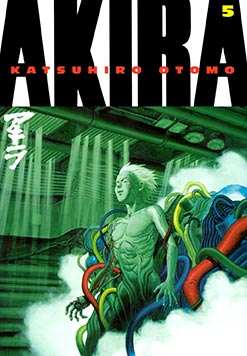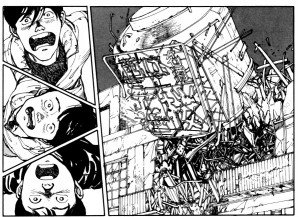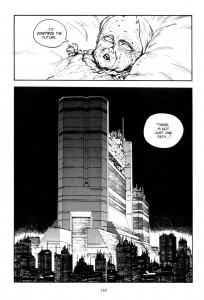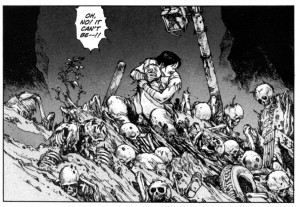SF Manga 101: Akira
Glenn Hough (gallyangel) is a nonpracticing futurist, an anime and manga otaku, and is almost obsessive about finishing several of the lists tracked on WWEnd. In this series on SF Manga Glenn will provide an overview of the medium and the place of science fiction within it.
 Oh, hello. I was just sitting here by the fire meditating on…well, ok. I was asleep. But I did think of something interesting to share before I get to Akira.
Oh, hello. I was just sitting here by the fire meditating on…well, ok. I was asleep. But I did think of something interesting to share before I get to Akira.
Nausicaa was originally published between February 1982 to March of 1994. Akira‘s original run was between December 1982 to June 1990. Ghost in the Shell’s initial release was between May 1989 to November of 1990.
I’ve maintained that Nausicaa, Ghost in the Shell (GITS), and Akira are the top three. This means that nothing published since ’94 has cracked the top three. Top five, yes. Top ten, absolutely. But not the top three. 18 years. I think that’s a long time to have no movement at that level. Nothing has come along which is that good, which is that important to SF. It’s an interesting observation for us to ponder.
Anyway, Akira. I’ve gotten the impression that of the mangas I’ve talked about in this series, it’s Akira that many of you might have heard of before. That Akira, much more so than GITS or Nausicaa, had a media punch behind it. It was a big deal way back when for the Epic/Marvel team to publish Akira. It was an even bigger deal for them to finish the series after several years of hiatus. So when Dark Horse says this about Akira, they say it with that big deal mentality:
Katsuhiro Otomo’s stunning science-fiction masterpiece, Akira! Regarded by many as the finest comic series ever produced, Akira is a bold and breathtaking epic of potent narrative strength and astonishing illustrative skill. Akira is set in the post-apocalypse Neo-Tokyo of 2019, a vast metropolis built on the ashes of a Tokyo annihilated by an apocalyptic blast of unknown power that triggered World War III. The lives of two streetwise teenage friends, Tetsuo and Kaneda, change forever when dormant paranormal abilities begin to waken in Tetsuo, who becomes a target for a shadowy government operation, a group who will stop at nothing to prevent another catastrophe like that which leveled Tokyo. And at the core of their motivation is a raw, all-consuming fear: a fear of someone — or something — of unthinkably monstrous power known only as…Akira. And Akira is about to rise!
And rise he does.
As I sit here flipping through one of my copies, what strikes me first is the “astonishing illustrative skill” Dark Horse was talking about. Give Otomo his props, he’s earned them. The epic story of Akira has this equally epic canvas for the action. Neo-Tokyo, more than any place in the mangas we’ve looked at so far, becomes a character in it’s own right. From the sloth and sin at one end, to the slums, biker bar, and decaying reform school on the other, Neo-Tokyo is alive. The barren wastes just outside the city proper where Akira went off the first time. The huge monolithic government buildings, full of the arrogance of power. The truly humongous underground military and science installation which held Akira. These places have that vast grandeur, that larger-than-life feel of ancient Rome. Big people, doing big things, in big places.
Even after Akira goes off again and we’re in the rubble of the city, Neo-Tokyo has the grandeur of shattered dreams. Or is that dreams which have turned into nightmares come true? It take skills to draw architecture. It takes even more to draw the same building with only a third of it left, since the destruction wasn’t complete. Again, props to Otomo.
There are so many threads one could talk about with Akira. The one which fascinates me is the changing neuroscience of our brain.
When I was a lad it was said that the human mind used only a fraction of the total available brain capacity. That idea turns out to be wrong. Today the analogy might be closer to using the world’s fastest computer, say the supercomputer Titan at the Oak Ridge National Laboratory which runs at 17.59 Petaflops a second, for nothing but word processing and online Japanese style riichi mahjong. In other words, complete overkill in terms of processing power compared to what you’re actually using it for. This, I think, strikes at one of the hearts of Akira, the potential which lies dormant in us all.
The children like Akira, as test subjects, were given drugs and direct brain stimulation to modify thought patterns, while also trying to produce a cascade effect of change in their DNA coding. The scientists opened a doorway into potentiality, only to try and slam it shut because uncontrollable power walked through. They succeeded too well and Tokyo paid the price in megadeath credit chips.
Otomo is using what could now be called a classic equation. Big science, which needs big money to operate, pushed too hard. Big money wants results – Now! from their funds spent, which of course, equals catastrophe.
Akira is science fiction, but I think the real question is whether the potentiality of human cognition in the Akira model will always be science fiction or not? Will Psi be part of the human equation? The “Mainstream Western Camp” of neuroscience, which is dominated by materialism, reductionism, and devout atheists, would say: No! Not a chance. The other camp, long on questions and short on dogma, would say: we don’t know. Not knowing, in the eyes of the “Mainstream Western Camp” is the great sin.
Otomo’s tale has many facets. The warning about how science can, and does operate, is only one of them.
 When it comes to obtaining copies of Akira, it’s more of a question of which edition do you want? There is the Epic/Marvel comic edition, which is 38 issues, flipped, and colorized. The Epic/Marvel Trade edition which is 8 issues, flipped, and colorized. The later Dark Horse six issue, flipped, black and white edition. (The Japanese standard for Akira is six issues. They’re nicknamed the Akira phonebooks.) Kodansha Comics currently holds the English rights. Their edition is six issues also. I believe it’s flipped as well. All are available. Kodansha’s edition is just a few mouse clicks away, while the Epic comic book series will require effort and patience to acquire.
When it comes to obtaining copies of Akira, it’s more of a question of which edition do you want? There is the Epic/Marvel comic edition, which is 38 issues, flipped, and colorized. The Epic/Marvel Trade edition which is 8 issues, flipped, and colorized. The later Dark Horse six issue, flipped, black and white edition. (The Japanese standard for Akira is six issues. They’re nicknamed the Akira phonebooks.) Kodansha Comics currently holds the English rights. Their edition is six issues also. I believe it’s flipped as well. All are available. Kodansha’s edition is just a few mouse clicks away, while the Epic comic book series will require effort and patience to acquire.



















 Full Details
Full Details





2 Comments
Another good post. Just had to request this from the library since they don’t carry one at my branch. I had the option of both the Dark Horse and Kodansha Comics varieties but the information confirms they are both flipped. Does the translation come out different between the separate printings?
Good question. The answer is, I don’t know. I’d have to dig out my Epic/Marvel comic book version and compare it to my Dark Horse one. I do know that translation from Japanese to English is a lot harder than say any of the European languages to English. There’s a lot more figuring out author intent and matching that with appropriate English. There’s skill and art at work with these translations, which is one of the reasons computerized translation is so hard. If you are reading a manga from the scanlation networks and then it gets an official English release, then you’ll definitely see a difference in the translation. Obviously it would be done by a different person, but it’s also a matter of the education level of the translator, the time they took with the translation, and their grip on those amorphous qualities that make or break a writer. Think of that old joke about IRS taxes. You can give the exact same tax info to three different preparers and get three different answers. It’s a similar phenomenon.
Sorry, the comment form is closed at this time.